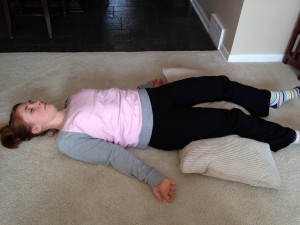Generalities on Breathing:
The breath is linked to the nervous system. Inhaling corresponds to your sympathetic fight or flight response; Exhaling corresponds to your parasympathetic stay and play response. Therefore when the exhale is longer then the inhale, relaxation and healing can occur in the body.Philosophy of Good Breathing:
Ancient Yogis believed that people have a certain number of breaths to live, not a certain number of years. If you want to see proper breathing watch a baby!
Most people do not breathe efficiently as a result of constricting clothes, poor posture or stress in a situation. Next time you are in a stressful situation take note of how you are breathing. Most times, stress or anxiety can cause the breath to become shallow, rapid and only from the chest or worse yet the breath is held. Redirecting breathing may allow perspective or feelings to be shifted about stressful situations. Also, in a position of poor posture with a rounded back and collapsed spine the diaphragm is unable to fully extend which causes breathing accessory muscles to work harder. (Think about those tight upper traps, levator scapulas and scalenes.)
Improper breathing changes the pH in the body, can cause one to pass out or faint and can even on a smaller scale leave one feeling fatigued and lethargic. Proper breathing is the fastest way to detoxify the body, the liver is actually resting next to the diaphragm. When you breathe your liver breathes with you.
Breath is the mirror of the mind. Here are some examples of what happens to our breath on a day to day basis:
• Resisting something- hold the breath
• Anger- short jerky, incomplete breaths
• Fatigue- long inhales through the mouth. YawnFor optimal health, breathing should be preformed nasally and should be full and rhythmic. The breath should come in through the nose and out through the nose. The nose is anatomically designed to filter and warm the air for the lungs, therefore try to use it as nature intended.
The diaphragm is the primary breathing muscle, accounting for 75% of the power of respiration. In order to breathe efficiently, the abdomen must expand so that the diaphragm has “somewhere to go.” The ribs and intercostals must pull the chest wall out to expand the lungs the rest of the way.
Exhaling breathes should last as long as the inhaling breath. Making the exhalation last twice as long as the inhalation is even more beneficial. By making the exhalation longer, the recoil capacity of the chest increases (slightly) as the second set of intercostals contract to return the rib cage back to its original position. Also, the pressure between the inside and outside of the lungs is exaggerated thus helping to pull more air into the lungs.
Breathing Exercise:
The easiest way to explore the breath is lying supine. You can also try breathing in a seated or standing posture. Try not to let the mind wander.
Three Part Breath:
2. Begin first by becoming aware of your breath. Simply observe the way your breath feels try not to alter or change it. Note where your breath moves in your body and how you feel.
3. Place both hands lightly on your lower abdomen just below the navel. Slowly begin to deepen the breath into your lower belly and feel the rise and fall of your belly as you breathe into this part of your body. Do not force your breath where it is not ready to go start where your body is ready to be and visualize your breath deepening until it is where you would like it to be.
4. Next slide both hands to the other parts of your rib cage and feel your breath expand in your ribs.
5. Keep one hand on the outer rib cage and one hand on the lower belly and feel the breath expand between the lower belly to the rib cage as your inhale and relax first from the ribs to the lower belly as you exhale. Let the breath be relaxed as you inhale and exhale and let the transition from belly to ribs be smooth and seamless.
6. When this two-part movement is comfortable for you imagine your breath starting in the lower belly expanding to the outer rib cage and ending just beneath your clavicles. Let the air you inhale and exhale move in a triangle pattern from belly to ribs to clavicles. Do not force your breath where it is not ready to go start where your body is ready to be and visualize your breath deepening until it is where you would like it to be.
Think about the inhale expanding and rising upwards from the belly to the chest and the exhale falling and returning inward on the exhale. Let go of all of the air in the body before taking the next inhale.

